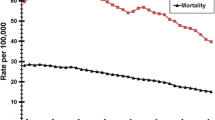Abstract
Testing for occult blood in stool is used frequently as a screening technique for colorectal carcinomas, but no study has ever shown an improved survival rate for colorectal carcinoma in patients screened by this method. Consequently, the authors have prospectively compared the sensitivity of endoscopy and occult blood testing in finding colorectal neoplasms. During the first year of the Surgical Endoscopy Service, 585 patients underwent sigmoidoscopy or colonoscopy. Seventy-nine patients (13.5 percent) were excluded from the study because their occult blood status was not recorded. Patients averaged 63+10 years of age and 98 percent were men. Of the 348 patients with occult blood negative stools 55.5 percent underwent colonoscopy and 44.5 percent underwent sigmoidoscopy. Polyps were found in 25.6 percent of these patients, colorectal carcinomas in 2.6 percent, and diverticulosis 36.2 percent. Of the 158 patients with occult blood positive stool, 76.5 percent underwent colonoscopy and 23.4 percent underwent sigmoidoscopy. Polyps were discovered in 39.0 percent of these patients, colorectal carcinomas in 10.1 percent, and diverticulosis in 43.0 percent. Thus, the occult blood test was negative in 59 percent of patients with polyps and 36 percent with colorectal cancers. These data indicate that lower gastrointestinal endoscopy is superior to occult blood testing in detecting colorectal neoplasms. These results further suggest that using the occult blood test as a screening test for colorectal neoplasms will result in a significant number of these lesions being missed at an early curable stage.
Similar content being viewed by others
References
Smart CR. Cancers of the colon and rectum in the United States: the scope of the problem. In: Beahrs OH, Higgins GA, Weinstein JJ, eds. Colorectal tumors. Philadelphia: JB Lippincott, 1986:3–7.
Ahlquist DA, Beart RW Jr. Use of fecal occult blood tests in the detection of colorectal neoplasia. Probl Gen Surg 1985;2:200–10.
Greegor DH. Occult blood testing for detection of asymptomatic colon cancer. Cancer 1971;28:131–4.
Winawer SJ, Andrews M, Flehinger B, et al. Progress report on controlled trial of fecal occult blood testing for the detection of colorectal neoplasia. Cancer 1980;45:2959–64.
Cummings KM, Michalek A, Mettlin C, Mittelman A. Screening for colorectal cancer using Hemoccult II stool guaiac slide test. Cancer 1984;53:2201–5.
Gilbertsen VA, McHugh R, Schuman L, Williams SE. The early detection of colorectal cancers: a preliminary report of the results of the occult blood study. Cancer 1980;45:2899–2901.
Ahlquist DA, Weinstein JJ. Tests for fecal occult blood in the detection of colorectal cancer. In: Beahrs OH, Higgins GA, Weinstein JJ, eds. Colorectal tumors. Philadelphia: JB Lippincott, 1986:39–47.
Buie LA. Proctoscopic examination and the treatment of hemorrhoids and anal pruritus. In: Practical proctology. Philadelphia: WB Saunders, 1938:17.
Gilbertsen VA, Nelms JM. The prevention of invasive cancer of the rectum. Cancer 1978;41:1137–9.
von Rokitansky C. A manual of pathological anatomy. London: The Sydenham Society, 1849;2:97.
Greene FL. Distribution of colorectal neoplasms: a left to right shift of polyps and cancer. Am Surg 1983;43:62–5.
Bohlman TW, Katon RM, Lipshutz GR, McCool MF, Smith FW, Melnyk CS. Fiberoptic pansigmoidoscopy: an evaluation and comparison with rigid sigmoidoscopy. Gastroenterology 1977; 72:644–9.
Holt RW, Wherry DC. Flexible fiberoptic sigmoidoscopy in a surgeon's office. Am J Surg 1980;139:708–10.
Bralow SP. Surveillance of average-risk populations for colorectal cancer. In: Beahrs OH, Higgins GA, Weinstein JJ, eds. Colorectal tumors. Philadelphia: JB Lippincott 1986:55–64.
Carlsson U, Ekelund G, Eriksson R, et al. Evaluation of possibilities for mass screening for colorectal cancer with Hemoccult® fecal blood test. Dis Colon Rectum 1986;29:553–7.
Wexner SD, Gregory WB, Wichern WA Jr. Sensitivity of Hemoccult® testing in patients with colorectal carcinoma. Dis Colon Rectum 1984;27:775–6.
Macrae FA, St. John JB. Relationships between patterns of bleeding and hemoccult sensitivity in patients with colorectal cancers or adenomas. Gastroenterology 1982;82:891–8.
Simon JB. Occult blood screening for colorectal carcinoma: a critical review. Gastroenterology 1985;88:820–37.
Bader J-P. Screening of colorectal cancer. Dig Dis Sci 1986; 31 (suppl):43S-56S.
Nivatvongs S, Gilbertsen VA, Goldberg SM, Williams SE. Distribution of large-bowel cancers detected by occult test in asymptomatic patients. Dis Colon Rectum 1982;25:420–1.
Sontag SJ, Durczak C, Aranha GV, Chejfec G, Frederick W, Greenlee HB. Fecal occult blood screening for colorectal cancer in a Veterans Administration hospital. Am J Surg 1983;145:89–94.
Hardcastle JD, Farrands PA, Chamberlain J, Amar SS, Sheldon MG. Controlled trial of faecal occult blood testing in the detection of colorectal cancer. Lancet 1983;2:1–4.
Gabrielsson N, Granqvist S, Nilsson B. Guaiac tests for detection of occult faecal blood loss in patients with endoscopically verified colonic polyps. Scand J Gastroenterol 1985;20:978–82.
Herzog P, Holtermuller K-H, Preiss J, et al. Fecal blood loss in patients with colonic polyps: a comparison of measurements with51chromium-labeled erythrocytes and with hemoccult test. Gastroenterology 1982;83:957–62.
Warden MJ, Petrelli NJ, Herrera L, Mittelman A. The role of colonoscopy and flexible sigmoidoscopy in screening for colorectal carcinoma. Dis Colon Rectum 1987;30:52–4.
Gryska PV, Cohen AM. Screening asymptomatic patients at high risk for colon cancer with full colonoscopy. Dis Colon Rectum 1987;30:18–20.
Author information
Authors and Affiliations
Additional information
Read at the meeting of The American Society of Colon and Rectal Surgeons, Houston, Texas, May 11 to 15, 1986.
About this article
Cite this article
Letsou, G., Ballantyne, G.H., Zdon, M.J. et al. Screening for colorectal neoplasms. Dis Colon Rectum 30, 839–843 (1987). https://doi.org/10.1007/BF02555420
Issue Date:
DOI: https://doi.org/10.1007/BF02555420




